Almost any software product that reaches the public market aims to solve a specific consumer problem and win profit for its owners. But how can you foresee if your solution will be successful and bring a positive return on your investment? It makes sense to check the idea, spending minimum money and effort before creating a multifunctional product version, right? That is why startups create an MVP.
We’ve already uncovered what an MVP is and how it can help startups. There are many types of MVPs available, suiting any budget and purpose. This guide will help you understand the MVP concept in-depth and define the most suitable type for your specific goal.
Why Are There So Many MVP Types?
It’s not a surprise that most startups fail. According to the latest report from Failory, 9 of 10 startups are unsuccessful. However, the lack of skills, knowledge, or fortune rarely leads to failure. The key reasons lie deeper and include the following:
- There was no need for such a product on the market.
- The cost and time for development went beyond the initial estimates.
- Incorrectly implemented functionality.
The basis for every new product is various assumptions. We assume that our potential clients need some service. We make assumptions regarding the time and resources we need to deliver this product or service to the market, what ROI we can expect, etc.
And if our assumptions turn out wrong, the entire project is at high risk of failing. That is why it’s vital to identify and check all such assumptions before going in big. An MVP (Minimum Viable Product) is a tool for testing assumptions (hypothesis) and collecting valuable feedback from actual and potential users.
Get more details on the Benefits of a Minimum Viable Product.
When it comes to testing the viability of a business idea, it is worth focusing on creating only those functions that directly solve the problem of potential users. That is the essence of creating an MVP. At this stage, all other additional options of an app should be ignored. - Andrey Onipriyenko, CTO at KeyUA
Depending on what kind of idea you need to check and what results you want to get, different types of MVPs can be used. To understand better what kind of minimum viable product fits your needs, let’s consider each one in detail.
Not sure what MVP model fits your startup idea? Let’s investigate the best approach for your needs.
Contact UsMain Types of MVPs for Startups
In a broad sense, all MVPs are divided into two categories — low-fidelity and high-fidelity. The first one combines rather primitive concepts but let’s not underestimate their value. Some ideas don’t need sophisticated and expensive approaches for validation. The second group features more advanced and resource-consuming techniques.
| LOW-FIDELITY MVP | HIGH-FIDELITY MVP | |
| Complexity | Basic, requires simple or no development | Profound results, requiring more complex development |
| Primary Goal | Understand the customer’s problem to find a suitable solution | Understand if the customers are ready to pay for your solution |
| Objectives |
|
|
| Types |
|
|
Low-Fidelity vs. High-Fidelity MVP
Low-fidelity MVPs are comparatively easy to develop. They give basic results that help to understand the needs of your potential customers. You can use it to find a primary direction for your startup and decide if your idea is worth developing.
High-fidelity types of MVP give more profound results yet require more resources for development. If you have already identified the customers’ needs and have an idea for a solution, high-fidelity MVPs help to determine if customers are ready to pay for it. Some high-fidelity MVPs help collect feedback from real users to develop the product further in the right direction.
Low-Fidelity MVP Types
If customers have a particular problem, it does not always mean that they are willing to solve it. That is why marketing research identifying customer needs is not enough to decide if your idea is worth developing. Low-fidelity MVPs help to define it more precisely.
1. “The Fake Door”
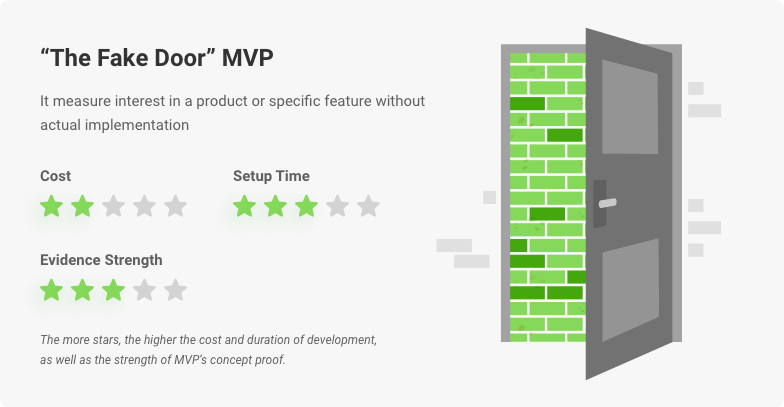
“The Fake Door” MVP is also called an “audience building MVP” or “An MVP before the MVP.” It helps to measure interest in a product or specific feature without actual implementation.
For example, you create a landing page that offers access to a feature you’d like to test. Let’s say you would like to know if people are interested in a new Premium subscription plan for your service that gives some additional options. You put the required information and a call to action button on a landing page and see how many people click on it. The button itself leads not to a subscription page or checkout. It leads to a message that this functionality is “under construction.” You can collect emails of interested users to notify them when it becomes ready.
Benefits:
- Great for discovering how potential users perceive the offer.
- Quickly proves or disproves the tested idea.
- It prevents a business owner from delivering the features and services that customers don’t want to use.
- Reduces the risk of losing funds on developing an unsuccessful product.
Drawbacks:
- Potentially can decrease your credibility, as some customers perceive such experiments as a scam.
- Implies lack of insights and distortion in results, as many users may interact with the ‘fake door’ for the sake of curiosity.
Reasonable uses:
- If you already have a customer base, “The Fake Door” MVP is a suitable tool to determine if they might be interested in a new feature or product.
“The Fake Door” MVP can be more than just a landing page. It can be a button in your existing web app, a short link, or any other asset. It is one of the low-fidelity types of minimum viable products that helps to measure the target audience for a specific product or service without much expense. It is suitable when you want to check if your idea is relevant by getting a general picture without validating the technical viability of the future solution.
2. Landing page MVP

It resembles the “The Fake Door” approach. However, you do not need to pretend that a product already exists before leading a user to a “coming soon” message. Here you introduce your product concept to site visitors and provide them a choice of potential options, like variants of subscriptions, different terms of use, pricing, etc.
is a great way to connect with your target audience and investigate the best scenarios for future development. Startups often lack feedback from potential users due to having no audience without having a ready-made product. Landing page MVPs solve this problem.
Benefits:
- Relatively inexpensive and easy to deploy.
- It is a concise tool to measure a unique value proposition. If you put a sign-up button to a landing page, you can evaluate if your service finds an echo in users before starting actual product development.
- By collecting email addresses or other contact information, you can easily follow up with these people for your marketing needs.
- You can use different messaging strategies by creating multiple landing pages to test which message gets the most interest from your target audience.
Drawbacks:
- While landing page MVPs generate interest in the product, there is no conversion factor provided.
- It implies limited data collection. If a landing page visitor chooses not to take action, there is no explanation why. Therefore, you cannot analyze what made people turn away.
Reasonable uses:
- If you need to get an initial customer base for product creation to define the content and features of the future solution.
3. Email Campaign MVP
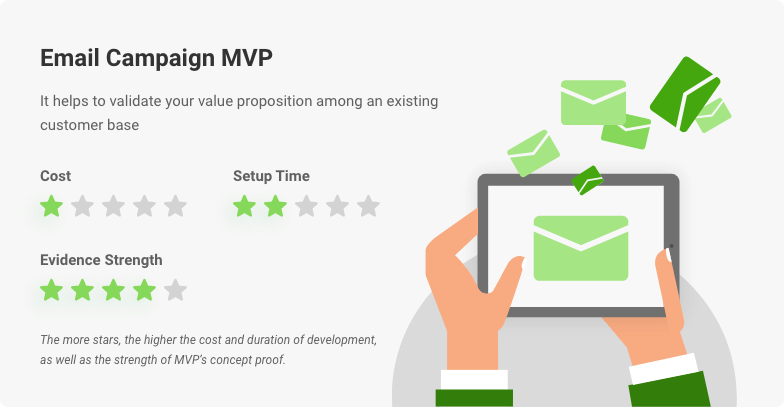
This MVP is reasonable to use if you have some email base of potential customers and want quickly to check if your new idea interests them.
Benefits:
- Comparatively cheap and fast to implement.
- It targets a specific audience.
- Allows direct interaction with each customer.
Drawbacks:
- Requires having an email base of target users.
- Email campaigns have low conversion rates, which may impact the results.
- Works best in tandem with a landing page MVP or other approaches as a follow-up step.
Reasonable uses:
- If you need to validate your value proposition among an existing customer base.
- If you’d like to determine whether your customers are interested in a new feature or product.
Compose a clear email text, a catchy title, and a bright image. Using specialized software like Mailchimp or ConvertKit, you’ll get detailed statistics regarding how many recipients opened your email, read it, clicked on the buttons or links inside, etc.
4. Marketing Campaign MVP
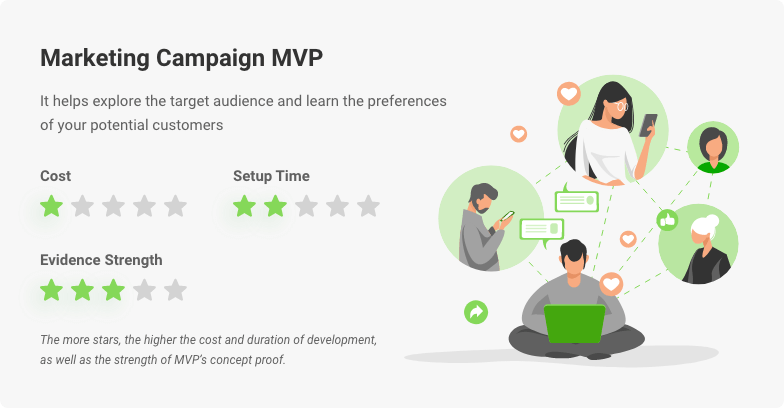
To investigate your target audience, you can use all free and paid promotional methods available today. With the rise of social networks, it has become easy to test a product or service idea on a broad audience. You can connect with influencers on social media, make posts to attract interest to your concept, and check if customers are willing to use it.
Benefits:
- It helps to discover which aspects of your product are most appealing to customers.
- It is flexible in terms of demographics and other target audience parameters.
- It is great for running split tests for obtaining comprehensive marketing statistics.
Drawbacks:
- Requires expertise in marketing analytics.
- To run comprehensive ad campaigns, you will need to make investments.
- It doesn’t give a lot of exposure. It is just an excellent tool for testing ideas and learning the target market.
Reasonable uses:
- When you need to explore the target audience and learn the preferences of your potential customers.
High-Fidelity MVP Types
While low-fidelity MVPs usually do not require any software development or significant investments, they also do not provide 100% certainty. They don’t help engage first adopters, as you do not have any product yet.
You cannot detect the directions for further development. All this becomes available within the adoption of high-fidelity MVP types.
5. Single-Feature MVP
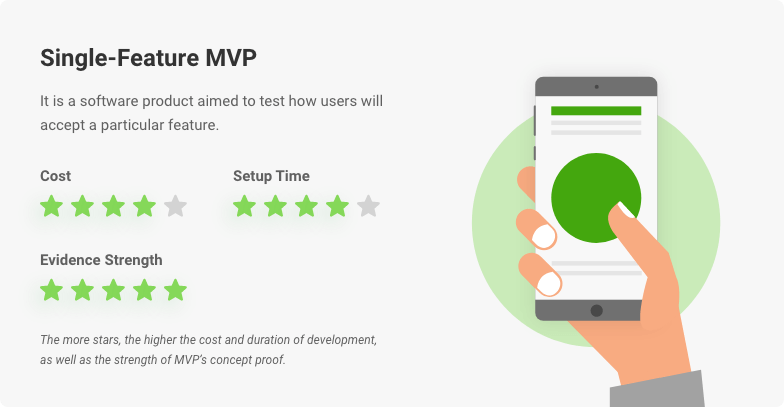
This is the most traditional option usually used to explain what an MVP is. It is a software product aimed to test how users will accept a particular feature. If you are sure of the core functionality of your future product, implement it in a single-feature MVP to check its viability on the actual market.
It is less expensive and time-consuming than creating a fully-featured solution. While it solves one specific problem for the customers, it should work exceptionally well. It will be your product’s first entrance to a market, and the way users perceive it will define the reputation of your product in the long run.
Benefits:
- Single-feature products are faster to develop and easier to explain to potential customers.
- It helps small businesses to enter a market with ‘big’ expensive competitors.
- It’s perfect if you want to turn some part of an existing solution into a separate product and need to test how users will perceive it.
Drawbacks:
- It provides lower user engagement compared to multi-functional products. Typically, the “single-feature” approach has a narrower target audience.
- Usually, such product MVPs receive multiple user complaints due to the limited functionality. However, if no complaints are received, users are not ready to pay for add-ons, or the product is not attractive.
Reasonable uses:
- It helps check the value and viability of a product that solves a specific customer problem.
Spotify started as a single-feature application for streaming music then added new features later. Another famous product that appeared as a single-feature solution is Foursquare.
It initially only allowed check-ins to hotels and receiving badges as part of its gamification process. After the service became popular, its founders added numerous features like reviews, guides, etc. We’ve collected the most standout MVP examples in a separate post.
6. Pre-order MVP
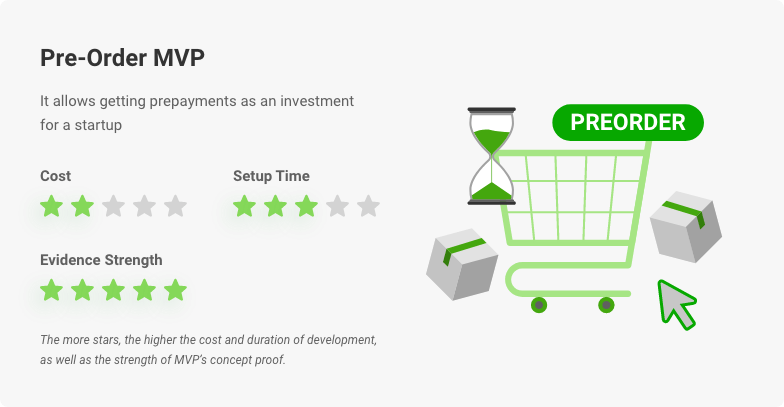
It is a solution that describes the future product and engages consumers to pay for it before its actual release. With its help, you can gain early adopters and get funds for further product development. Using this type is reasonable if you have a unique and exciting offer.
While a pre-order MVP allows getting prepayments as an investment for a startup, it imposes certain risks. For instance, you need to ensure the quality and usability of the end product to satisfy the customers' expectations that have already invested their money in your project. Also, it gives less feedback than an ordinary “sign up for updates” landing page MVP. Unless you have a reputation of a world-renowned successful business owner, people might feel suspicious when paying for a non-existent product.
Benefits:
- It allows making money from nothing. But, you become responsible for your promise to customers.
- You can test the demand for certain functionality before development.
Drawbacks:
- Depending on the product complexity and investments required for its development, sometimes you can start its creation only after collecting the required number of pre-orders.
- Sometimes the collected payments do not directly reflect the demand for the final product if a famous industry leader conducted the pre-order MVP. It can be a result of the company's reputation.
Reasonable uses:
- If you need to receive prepayments for the development process or check whether your customers are ready to pay for the product.
7. Concierge MVP
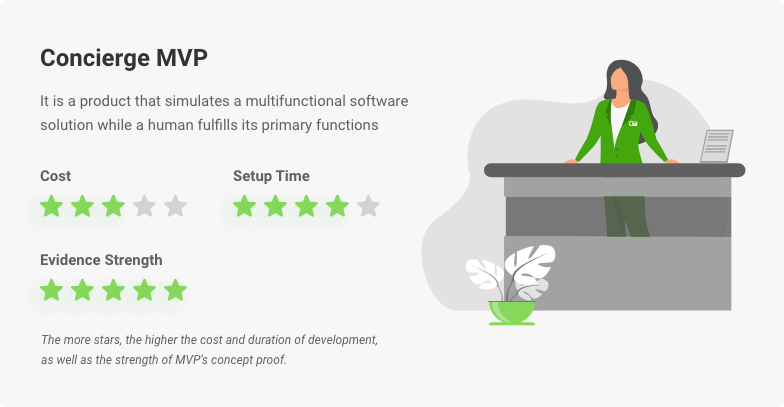
It is a product that simulates a multifunctional software solution while a human fulfills its primary functions. The bottom line is that you accompany the user all the way through the use of the product, and they know about it.
It helps test the solution’s effectiveness and popularity before it gets completely developed. This way, a startup company can save resources before ensuring that the end product will get enough interest from the target audience.
Benefits:
- You can validate your product and raise capital before you get it fully developed and automated.
- You don’t need to wait months or even years to see how your final product will behave. You get it fully up and running through your MVP.
- This MVP provides accurate user behavior data dealing with real customers and provides all final product features.
Drawbacks:
- A Concierge MVP relies entirely on human competency. To ensure the quality of service, you need reliable operators. Finding people that seamlessly mimic the automated services can be challenging.
- You’ll need to find a suitable partnership model with other companies to handle some operations.
Reasonable uses:
- Learn customer behavior and find the best way to automate the provided services in a cost-efficient manner.
- Evaluate the demand and find out who is really interested in your product.
Zappos, one of the largest retailers in the USA, began as a concierge online shoes store in 1999. At that time, its founder wasn’t sure that people would actively buy footwear online and decided to test this idea with minimum investments. He made photos of shoes in the mall and posted them to a catalog on his website. When a pair of shoes was ordered, he would buy them in the mall and send them to the customer. Further, it turned into one of the largest online retail stores for multiple categories of goods, and in 2009 Amazon purchased it for about $1.2 billion.
8. Wizard of Oz MVP
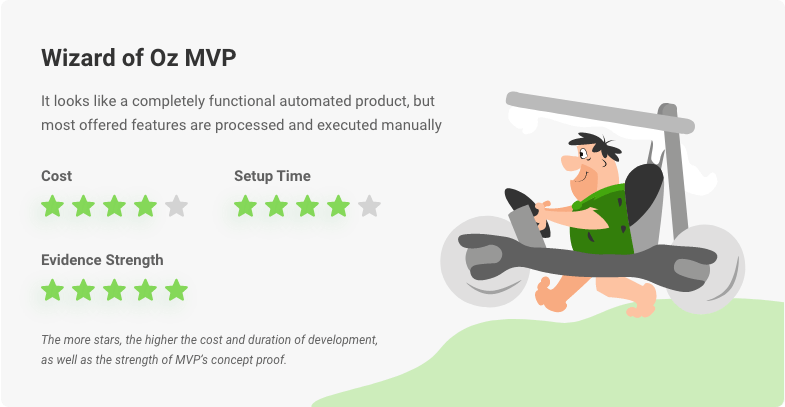
The MVP product created by this principle looks like a completely functional product with all required features on board. However, most offered features are processed and executed manually. And unlike Concierge MVP, users do not know about it. This type is suitable to test ideas that require sophisticated technologies (e.g., machine learning).
Benefits:
- Wizard of Oz helps test the market’s demand with no need to build an expensive product prototype.
- It provides rapid iterations, as any changes made to the workflow are immediately testable.
- It gives unique insights regarding users’ behavior.
Drawbacks:
- It is difficult to ensure the consistency of interactions with users due to the human factor behind the Wizard.
- It requires detailed behavior instructions for different reactions and situations occurring while servicing users.
Reasonable uses:
- If a product requires the development of complex algorithms and processes automation, and you need to get customers as soon as possible.
- Suitable for entering the market in complex industries (finance, jurisprudence).
This type of MVP is also called a Flinstone MVP. Both names reflect its key concept: a customer thinks they are using a modern automated product when, in fact, it is all done by a human behind a curtain. At first glance, the Wizard of Oz concept seems similar to a Concierge MVP. These types of minimum viable products have a common principle, yet there is one big difference: consumers know about the concierge, while the Wizard of Oz is hidden from the end-user.
9. Piecemeal MVP
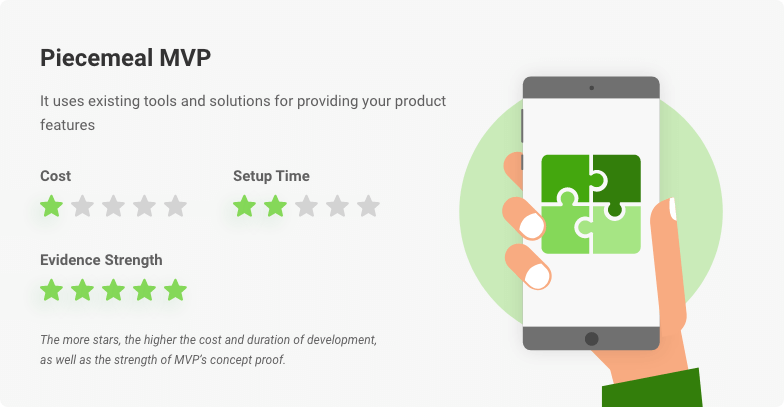
It is another cost-effective way to present a product to customers. The idea of this MVP is to use existing tools and solutions for providing your product features. For instance, you can offer goods from other stores in your catalog and use third-party services for order delivery. Moreover, you can use ready-made marketplaces instead of developing unique software from scratch.
Benefits:
- Faster time-to-market with fewer expenses compared to developing a custom product from scratch.
- You can benefit from using all the advantages of existing products that can already solve your customers' problems.
Drawbacks:
- If you need to implement multiple features, it can be difficult to find existing solutions to cooperate seamlessly.
- Choosing third-party solutions is not always the most technological and quickest way to deliver results to customers.
Reasonable uses:
- If you are entering a market dominated by mature competitors.
- If you want to develop a product with hardly any predictable logistics.
- If you are limited in technical resources yet have a great product idea.
The Groupon MVP was made using a piecemeal principle. It connects customers with local grocers, local retailers, tourist agencies, and other companies and offers discounts for their services. Initially, it was built on WordPress, used FileMaker to generate PDF coupons, and Apple Mail for sending emails with attached coupons.
What Type of MVP is Best for You?
The preferred fidelity depends on how much the future MVP needs to look like the final product. Andrey Onopriyenko, the KeyUA Chief Technology Officer, points to two other aspects for choosing the right type of MVP in business:
Many startups generate product ideas in response to urgent problems that arise in the market. For example, in 2020, the pandemic triggered the appearance of numerous online delivery services and software tools for remote business operations and working from home. In this situation, it’s essential to begin testing the idea and receiving customer feedback as soon as possible. Normally, it makes sense to start with a low-fidelity MVP because it implies minimum investment and faster response. Further, you can consider moving to high-fidelity models after the product usefulness and relevance has been approved.
After you defined the required fidelity, you can narrow down the suitable range of MVP types by answering a few critical questions:
- What is the highest risk you currently have? How can you check it?
- What is the available time frame for building an MVP and receiving results?
- How much money do you currently have? What amount can you spend on an MVP?
Validating your hypothesis at the initial stage should not eat up your entire budget, as it's too risky for a startup. Consider an amount that will be smart to use without risking bankruptcy before starting product development.
Final thoughts
An MVP concept goes widely beyond the traditional single-feature software prototype. Multiple idea validation strategies work for different goals and different types of products. Choosing the right MVP for a startup app helps run cost-effective and effort-effective experiments while getting meaningful results for further development.
KeyUA provides the full line of MVP development services, assisting startups in choosing the right MVP approach and building required assets for successful customer engagement. Feel free to consult our software engineers and marketing specialists regarding your product development.
We are happy to support you at every stage, from idea identification to market launch and further improvements. Let’s turn your ideas into a successful business!
Have an exciting idea for a software startup? Develop a robust yet cost-efficient MVP to validate your concept on a real market.
Start Now


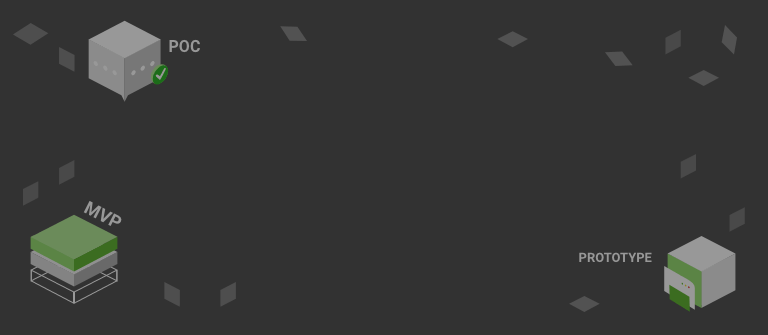


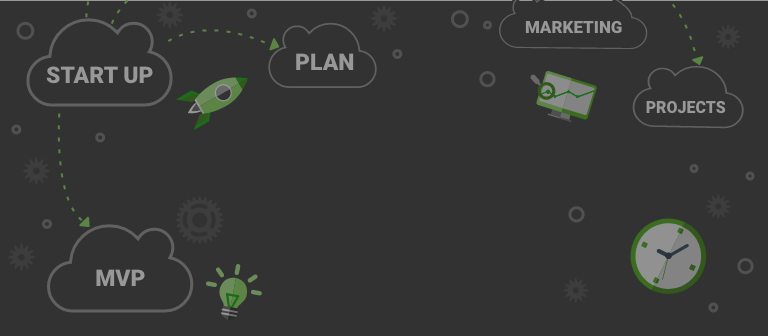


 Unit 1505 124 City Road, London, United Kingdom, EC1V 2NX
Unit 1505 124 City Road, London, United Kingdom, EC1V 2NX

Comments
Leave a comment